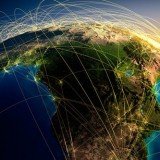The Uninhabitable Earth (2019) Book Summary and Insights
Book Title: The Uninhabitable Earth
Subtitle: Life after Warming
Publication Date: 2019
Author Name: David Wallace-Wells
Book Summary
The Uninhabitable Earth sheds light on just how much harm we are causing the globe with our negligence, carelessness and disregard for the environment.
David Wallace-Wells does more than show us the doom waiting for us if we don’t do something about climate change. He explains to us the meaning of climate change and how it will affect our culture, well-being, emotions, and even politics. He draws his stories from facts and figures backed by expert quotes.
He does not sugarcoat his words or try to soften the blow for us; Wallace-Wells lays the facts down straight, opening our eyes to the perilous position we are in.
From the reemergence of extinct diseases to wildfire outbreaks, the book touches on what we can expect in the next couple of decades because of global warming.
Who Is This Book For?
This book is for anyone curious to learn more about environmental changes and the effects of global warming. It is for ECO-friendly people who need more insight on why we must save our planet. Anyone affected by the changes the Earth suffers from should read this book.
About The Author
David Wallace-Wells is an American journalist. Pages like the New York magazine and The Guardian have recognised his work.
The Uninhabitable Earth was formerly a magazine article published in 2017, depicting the worst-case scenario our planet could face because of the effects of global warming.
Wallace-Wells serves as a deputy editor for New York magazine, writing about the future of science and technology and how climate change affects our lives.
Buy Book: Support The Author And Our Work
Great books should be read, studied and reviewed, so reading the actual book may provide more value to you than the book insights on this page. This will also support the work of the book author and what we do on LarnEdu.
Important Notes
We get a small compensation from Amazon when you visit your nearest/local Amazon site via our affiliate link to purchase an item within 24 hours or if you add it to your cart and checkout within 90 days. This is no additional cost to you and supports our work.
The information on this page is meant to supplement the actual book(it is not a book review but distils the key insights or ideas from the book in under 5000 words). The content creator or LarnEdu does not necessarily support the views, thoughts, and opinions expressed in the text/book. Reasonable skepticism should be applied with any views, thoughts or opinions expressed/shared by the book author or content creator.
Reading the contents of this page does not guarantee specific results. The best lessons are achieved from taking consistent action in the real world rather than being addicted to the illusion of progress by getting stuck on reading an infinite amount of books or book summaries and insights. LarnEdu and the content creator accepts no responsibility or liability for the accuracy of the information on this page or how it is used.
Book Insights

Introduction
Your brief flicks through the Discovery and Nature channels probably give you a little insight into what our careless living is doing to our Earth. The weather gets worse every year even though we do not fully appreciate the downslide.
David Wallace-Wells gives us an insight of just how close we are to doom with his book. He talks about the damages we as a generation have caused on the Earth and how potentially disastrous those damages could be.
The Uninhabitable Earth sets to reveal to us the consequences of our careless living; from floods of biblical proportions to unexpected climate change effects. Wallace-Wells advises us to buckle up for the long, hot ride.
The Paris Climate Agreement Addressing Climate Change
Climate change has become more than just longer heat waves and ocean pollution. The universal problem has become so urgent that in 2015, there was a meet of world leaders in Paris. The goal was to meet and discuss the ways to deal with climate change, and to reach a favourable solution.
The first agreeable decision was to maintain temperatures at 2 degrees Celsius higher than the previous levels; levels thought to cause climate problems. The problem is that these changes are being applied a little too late. Reports have stated that even with the Paris changes put in place, climate temperature increase will keep rising till about 3.2 degrees at least. That already seems pretty bleak but, when you include the fact that no country has yet implemented those policies, and you see we are in an even bigger mess.
Experts have estimated that by 2100, equatorial places will be uninhabitable at 8 degrees, tropical disease will increase, and over half of the world’s cities will experience flooding.
We can liken the consequences of climate change on the Earth to a domino effect. What this means is that different things factor into how badly climate change affects our planet.
A “cascade” is a phenomenon where an effect of climate change causes even more effects, which causes more effects, and on and on in an unending loop. In the Arctic, the more ice sheets melt, the warmer our planet gets. This is because ice reflects sunlight into space and, an absence of these ice sheets to turn away the heat causes more absorption of sunlight and heat.
On heat, we have reached the point where 16 of the hottest years recorded have occurred since 2000. The heat means we are more vulnerable to heat-related fires; wildfires.
Wildfires are doing more than just burning down our homes and destroying trees; they cause more release of carbon in the air because, when fires burn trees down, it releases the carbon stored in those trees into the atmosphere.
A huge cause for alarm is that these extreme weather are now so frequent we have taken them to be almost normal. Even though the weather disasters are not at their peak now, the wrath is still being felt in places and; the author warns that we are yet to experience the full weather wrath.
Storms, rainfall, flooding and hurricanes are all related to global warming and, as the heat situation get worse, so does the intensity of these weather. Statistics have shown that since 1980, the number of storms and storm-related damages the United States has dealt with has more than doubled.
Take, for example, tragedies which are still fresh in our memories; Hurricane Irma and Hurricane Maria – both Category 5 hurricanes which both caused about $158 billion in damages and claimed over 3,000 lives.
What all this sums up to is that even if we all put in our best efforts starting tomorrow and implement some Paris targets, our Earth remains doomed. We can expect more hurricanes in the near future if warming increases in the slightest and almost all climate change effects cause a cascade.
Basically, it is all too little, too late, and we are all doomed, anyway.
Effects of Climate Change
Now we have touched on the how and why of climate change, we can take a deeper dive into its effects on our planet.
We already talked about how ice sheets melt and the effects it has on our weather but, the part we didn’t talk about is its effects on sea levels. Ice is melting so fast that calculations have shown that water levels will rise between 1.2 and 2.4 metres before the end of the next century. Little rise in ocean levels like that will have cataclysmic effects – Bangladesh and a host of the world’s beaches would find themselves under water.
Bringing things closer to home, if we do not slow down with the damage we are causing our climate, several internet servers and fibre optic cables could be below water by 2040.
Climate catastrophes will do more than wash away our homes and properties if we do not take care. Feeding and nourishment is man’s priority; before even shelter. So, what happens when you take away the surplus of food man has gotten so used to?
What could cause this? The planet heating by as little as just 1 degree already causes a 10% decrease in cereal crop yield. So, let’s look at a world which has gotten warmer by 5 degrees. That means there would be 50% less grain available. Also alarming is that fact that these grains are growing less nutritional as our climate changes.
Climate change is a huge force gaining traction with each year and, our precious innovations and progress could go down with the ice as the Earth warms up.
The Arctic ice sheets are melting; we have already established that. What we might not know of is the bacteria and extinct germs in those sheets. Think about diseases older than man, so old they would overwhelm our immune systems on what to do; and other diseases like smallpox.
If you think those diseases are too well contained to pose a real threat, let’s talk about the ones floating round now. Bacteria love humid, and warm places; they thrive there. Since our planet is heating faster than we could have imagined, we can easily do the math and see how disease could spread more easily. Think about the rapid spread of malaria and Lyme disease outbreaks in more countries.
What can we do to at least slow down these end results? Experts have said that our actions in the next decade will have a large part to play in our planet’s safety. In America alone, each person emits about 10,000 tons of ice-melting carbon.
Air and Water Pollution
A study in 2017 showed that breathing New Delhi air is doing about the same damage as smoking two packs of cigarettes. Air pollution is real and is a huge threat; air pollution causes over 10,000 deaths.
Another 2018 study showed that air pollution has such an effect on our cognitive health that Chinese intelligence levels could go up by 13 percent if they maintained the EPA’s clean air standards.
Even though air is man’s most essential need, higher than even food, water is placed close behind in terms of importance. Water makes up 71% of the Earth’s surface, makes up for about 60% of our bodies, and is essential for most of our day-to-day functions.
Water scarcity is not the biggest threat we face but it could be if we do not change our ways. We need freshwater to survive and; the Earth has a majority of saltwater, with the former coming in at just 2%. With these numbers, experts have deduced that in the next two decades, the demand for water will be higher than supply by at least 40%. This means that overpopulation will cause an increase in water demand because of the need for more crop and agriculture – which would account for even more water.
Lake Chad has lost 95% water volume since the 60s, and the Aral Sea has lost 90% water volume – staggering.
The UN’s calculations estimate that five billion people could be without freshwater supply by 2050.
A Solution to Our Global Dilemma
Ever wondered why the average person behaves ten times worse in hotter weather? It’s because climate change affects human behaviour just as much as it affects our environment.
Heat and pollution are two proven factors that affect our responses in situations where we could react differently in a more conducive weather. A survey of the United States showed that higher pollution can be linked to an increase in petty and aggravated crimes.
Looking at it on a larger scale, studies present that climate change has affected the chances of conflict in countries in Africa by as much as 10%.
It seems like our Earth is in trouble no matter which way we look, even armed as we are with our technology and ground breaking inventions.
The author offers a beacon of hope in the seemingly endless dark tunnel. He presents “negative emissions” – an approach that would involve carbon capture and storage and mechanically sucking carbon out of the air.
However, like most cures, these come with their own setbacks; which include that there is the risk of poisoning the air with more carbon if the procedures get done incorrectly and, the cost of building enough of these machines is nearly inconceivable to gain.
The Earth suffers because of our careless living, shouldn’t we be willing to go the extra mile to preserve our planet, or at least save it from further harm? It might seem like a herculean task you alone cannot rise to but, every person’s attitude to the climate matters.
Key Quotes
“Humans, like all mammals, are heat engines; surviving means having to continually cool off, as panting dogs do. For that, the temperature needs to be low enough for the air to act as a kind of refrigerant, drawing heat off the skin so the engine can keep pumping. At seven degrees of warming, that would become impossible for portions of the planet’s equatorial band, and especially the tropics, where humidity adds to the problem. And the effect would be fast: after a few hours, a human body would be cooked to death from both inside and out. At eleven or twelve degrees Celsius of warming, more than half the world’s population, as distributed today, would die of direct heat. Things almost certainly won’t get that hot anytime soon, though some models of unabated emissions do bring us that far eventually, over centuries. But at just five degrees, according to some calculations, whole parts of the globe would be literally unsurvivable for humans. At six, summer labor of any kind would become impossible in the lower Mississippi Valley, and everybody in the United States east of the Rockies would suffer more from heat than anyone, anywhere, in the world today. New York City would be hotter than present-day Bahrain, one of the planet’s hottest spots, and the temperature in Bahrain “would induce hyperthermia in even sleeping humans.”
“It is worse, much worse, than you think. The slowness of climate change is a fairy tale, perhaps as pernicious as the one that says it isn’t happening at all, and comes to us bundled with several others in an anthology of comforting delusions: that global warming is an Arctic saga, unfolding remotely; that it is strictly a matter of sea level and coastlines, not an enveloping crisis sparing no place and leaving no life undeformed; that it is a crisis of the “natural” world, not the human one; that those two are distinct, and that we live today somehow outside or beyond or at the very least defended against nature, not inescapably within and literally overwhelmed by it; that wealth can be a shield against the ravages of warming; that the burning of fossil fuels is the price of continued economic growth; that growth, and the technology it produces, will allow us to engineer our way out of environmental disaster; that there is any analogue to the scale or scope of this threat, in the long span of human history, that might give us confidence in staring it down. None of this is true. But let’s begin with the speed of change. The earth has experienced five mass extinctions before the one we are living through now, each so complete a wiping of the fossil record that it functioned as an evolutionary reset, the planet’s phylogenetic tree first expanding, then collapsing, at intervals, like a lung: 86 percent of all species dead, 450 million years ago; 70 million years later, 75 percent; 125 million years later, 96 percent; 50 million years later, 80 percent; 135 million years after that, 75 percent again. Unless you are a teenager, you probably read in your high school textbooks that these extinctions were the result of asteroids. In fact, all but the one that killed the dinosaurs involved climate change produced by greenhouse gas. The most notorious was 250 million years ago; it began when carbon dioxide warmed the planet by five degrees Celsius, accelerated when that warming triggered the release of methane, another greenhouse gas, and ended with all but a sliver of life on Earth dead. We are currently adding carbon to the atmosphere at a considerably faster rate; by most estimates, at least ten times faster. The rate is one hundred times faster than at any point in human history before the beginning of industrialization. And there is already, right now, fully a third more carbon in the atmosphere than at any point in the last 800,000 years—perhaps in as long as 15 million years. There were no humans then. The oceans were more than a hundred feet higher.”
“the relationship of pollution to premature births and low birth weight of babies is so strong that the simple introduction of E-ZPass in American cities reduced both problems, in the vicinity of toll plazas, by 10.8 percent and 11.8 percent, respectively, just by cutting down on the exhaust expelled when cars slowed to pay the toll.”
“If the average American were confined by the carbon footprint of her European counterpart, U.S. carbon emissions would fall by more than half. If the world’s richest 10 percent were limited to that same footprint, global emissions would fall by a third. And why shouldn’t they be?”
Conclusion
Every year brings us more news of melting ice caps and raging storms. We see the climate change awareness programs and “Save the Planet” movements. Maybe we cast this news aside as ramblings from tree-huggers but climate change is happening and is much worse than we think.
We may not prevent it completely but, we can slow it down and make our climate more habitable for us.
Since You’re Here…
Great books should be read, studied and reviewed, so reading the actual book may provide more value to you than the book insights on this page. This will also support the work of the book author and what we do on LarnEdu.
Furthermore, you can support LarnEdu by making a one-off or monthly donation (via PayPal) for as little as £0.99 or by sharing this content.
Got any feedback or suggestions? Use the comment section below or send us a message.















